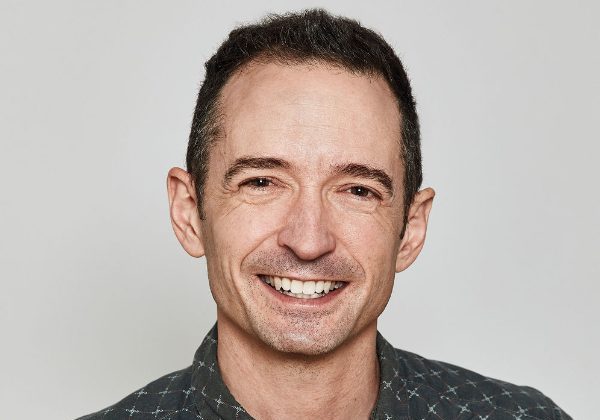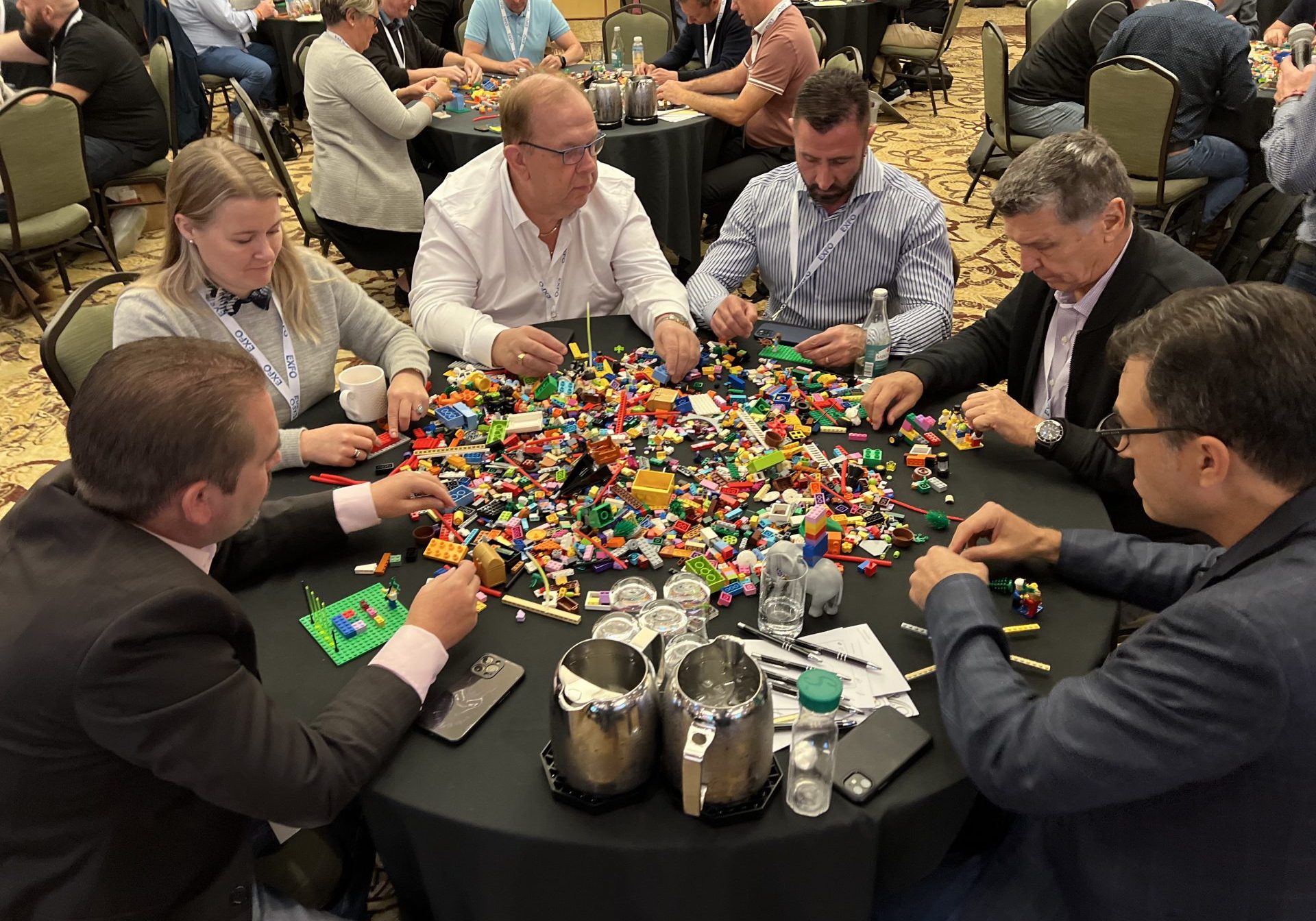Simon Bourdeau is a professor at UQAM’s School of Management Sciences and a workshop leader at La Factry. His research focuses on the dynamics of collaboration in the workplace. He uses the Lego Serious Play method to help teams work together.
How did you come to think about creativity and collaboration in the workplace?
I come from an IT background, so not a “creative” background. But, as a teacher, I have a great curiosity for pedagogical innovations-which is what led me to the Lego Serious Play method, which we will talk about later. And if not, for several years, I have been interested in team dynamics through my research. My dissertation in the late 1990s was on the effects of diversity in work teams. So collaboration has always been an underlying interest of mine.
Especially since the pandemic exploded, and with it the collaborative platforms, we realize the benefits of collaborative work. Having a 360-degree view of a situation allows, for example, to manage risks, create wealth, and succeed in different markets.
How can collaboration foster the emergence of a creative context?
It is the whole dynamic of exchanging perspectives and confronting ideas that facilitates creativity, at least when it is done in a respectful way, with a clear objective, in a determined time frame, and when each of the people involved knows his or her contribution, strengths and those of others.
But collaboration is a means, not an end.
Precisely: in your opinion, what is the most common mistake made by organizations trying to increase collaboration in their team?
One of the most common mistakes is not knowing why we collaborate. What is the goal? Could we achieve the same result without collaboration? You have to get back to the big why.
And you have to be aware of the specifics of collaboration. Collaboration takes time, it takes money, it takes effort, and it doesn’t always get the results you want.
You also need a person or persons responsible for coordinating the activities, a kind of conductor who takes care of the logistical and relational work: setting up the meetings, reserving the premises, planning the topics of discussion… It is a very important job, and often in the background.
As a workshop leader on creativity, you work with a rather original tool: Lego Serious Play, or LSP. In a few words, can you summarize what it’s all about?
Lego Serious Play is a method of reflection, communication and problem solving for groups working on real situations, in real time. Basically, it gets people talking to each other, thinking together and listening to each other.
It’s a four-step process: first, we pose a challenge related to the issue at hand (we have to take the time to script the workshops well to get the maximum number of results related to what we’re looking for); then, each person has a few minutes to build his or her Lego model (often, to break the ice, we start by having them build a tower that represents them); then, each person shares what his or her model signifies, the ideas that are in it, etc.; and finally, we have a discussion about the results. Finally, there is a discussion, during which the group can brainstorm, ask questions…
It’s a method that allows people to formulate their ideas well, to think a little, but not too much, and then it gives them the time to be listened to, and the time to listen. It sounds simple, but that’s really the strength of this tool.
What attracted your interest in this method?
Lego [laughs]. On a more serious note, I started teaching in the early 2000s, and I thought, I’m not going to lecture. I was looking for experiential teaching approaches. I ended up trying a Lego exercise in class. It wasn’t the LSP method, but it was already great. Then I came across LSP. I realized the power of this tool-which, by the way, has some very interesting scientific foundations that I won’t go into here-and I went to train with the two Lego Serious Play super-trainers in Copenhagen.
What spoke to me was the power of the tool, its universality, and the fact that it allows people to express themselves and be heard in a safe environment. And it can be used in many contexts. Just last night, I was talking with a colleague who is going to conduct an LSP workshop in a second grade classroom to motivate children to express themselves.
How does play help teams work together better?
When you play, even if you get it wrong, it doesn’t matter. Usually, when you’re in a work environment and you make a mistake, there are consequences. In a game like Lego, there are no rules, the goal is not to arrive first, to have the most points… You are just there to play, to experiment.
Compared to other artistic mediums that can be more embarrassing, for example drawing or modeling clay, with Lego Serious Play, everyone uses the same blocks, and we don’t care about your construction: it’s what you’re going to tell that counts.
LSP is a language. The fact of expressing yourself with blocks smoothes out hierarchical, cultural, sectoral differences… You can have people in human resources, engineers, people who have different realities and vocabularies and, as the method uses metaphors (the constructions) and depersonalizes the ideas (we talk about our model, not about ourselves), they will quickly have a common understanding, a common language.
And it is a great tool to get to know each other. Plato said something like: you can know more about someone in an hour of play than in a year of conversation. And there is nothing more true. The choices we make in our construction, the way we describe our model, it says so much about us, it’s crazy.
What would you say to someone who doubts that a game can deliver real, serious results?
I’m not here to preach: I’ve never wanted to force anyone, because there’s no point in going into this backwards. But I would say that the best way to melt a person’s apprehensions is to have them build something. I always have blocks in my backpack. So I have them build something simple, and I ask them to describe what they’ve built, and I get them to talk a little bit. After five minutes, people usually see that the game is effective in talking about a lot of things. So you have to try it out in practice.
As a workshop leader at La Factry, what part of the training or coaching process turns you on the most, and why?
Of course, I like leading workshops, but the whole upstream part, the brainstorming with the La Factry team, really turns me on. In problem solving, the problematization is often the most difficult and important part, and La Factry is very strong on that part. There’s a focus on really identifying the need, and brainstorming on how to meet it by customizing generic solutions. It’s the embodiment of collaborative work, creativity and risk-taking. It’s the behind-the-scenes work that makes La Factry and the workshops so special, I think.
Personally, do you have a surefire trick or ritual to get you back into a creative frame of mind even in the hustle and bustle of everyday life?
Breathe. Just that.
Sometimes, when you’re too stuck in a routine, when you have goals, when you’re under pressure, when you’re in the details, you forget to breathe. We forget to step back and remember who we are, why we’re here, and what we could be doing differently. And breathing brings us back to that level.


